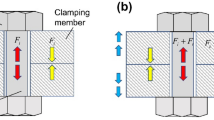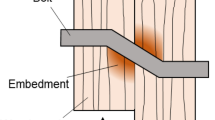Abstract
This paper presents experimental research on the behavior of bolted timber joints subjected to high temperatures. Tests for the determination of the embedment strength parallel to the timber grain and the load-bearing capacity of single- and three-bolt joints were carried out. The tested temperatures were 20, 50, 100, 150, 200, and 230 °C. The specimens were made of Pinus taeda timber with a density varying from 427 to 524 kg/m3 and moisture content of 12% at 20 °C. The results have shown that the temperature and moisture content significantly influence the load-bearing capacity of the joints. Higher temperature leads to a nonlinear decrease of resistance, with minimum values at 50 and 100 °C for the single- and three-bolt timber joints, respectively. This behavior is associated with degradation of the polymers and changes in the moisture content of the timber.
Zusammenfassung
In dieser Arbeit wird das Verhalten von Bolzenverbindungen, die hohen Temperaturen ausgesetzt sind, untersucht. Geprüft wurde die Lochleibungsfestigkeit in Faserrichtung sowie die Tragfähigkeit von Verbindungen mit einem und mit drei Bolzen bei Temperaturen von 20, 50, 100, 150, 200 und 230 °C. Die Prüfkörper bestanden aus Kiefernschnittholz (Pinus taeda) mit einer Rohdichte zwischen 427 und 524 kg/m3 und einem Feuchtegehalt von 12 % bei 20 °C. Die Ergebnisse zeigten, dass die Temperatur und der Feuchtegehalt einen signifikanten Einfluss auf die Tragfähigkeit der Verbindungen haben. Höhere Temperaturen führen zu einer nicht linearen Abnahme der Tragfähigkeit, mit dem niedrigsten Wert bei 50 °C bei Verbindungen mit 1 Bolzen bzw. 100 °C bei Verbindungen mit drei Bolzen. Bei diesem Verhalten spielen der Polymerabbau und die Holzfeuchteänderungen im Schnittholz eine Rolle.










Similar content being viewed by others
References
Almeida P (1987) Timber nailed joints. MSc thesis, University of São Paulo, Brazil (in Portuguese)
Back EL, Salmén NL (1982) Glass transition of wood components hold implications for molding and pulping processes. Tappi J 65(7):69–279
Chafe S (1979) Growth stresses in trees. Aust For Res 9:203–223
Correia NDF (2009) Behavior of timber joints subjected to high temperatures. Master thesis in structures, University of Coimbra, Portugal (in Portuguese)
Durbak I et al. (1998) Wood. In: Encyclopedia of chemical technology, vol 25, 4th edn. Wiley, New York, pp 627–664
EN1995-1-1 (2004) Eurocode 5: Design of timber structures. Part 1-1. General common rules and rules for buildings, CEN, Brussels
EN 1995-1-2 (2004) Eurocode 5: Design of timber structures. Part 1-2. General—Structural fire design, CEN, Brussels
EN 13183-1 (2002) Moisture content of a piece of sawn timber. Determination by oven dry method, CEN
Fornather J, Bergmeister K, Hartl H (2001) Fire behavior of steel fasteners in wood composites—experimental analyses. In: Proceedings of the RILEM congress on joints in timber structures, Stuttgart, Germany
Fredlund B (1993) Modelling of heat and mass transfer in wood structures during fire. Fire Saf J 20:39–69
Irvine G (1984) The glass transitions of lignin and hemicellulose and their measurement by differential thermal analysis. Tappi J 67(5):118–121
König J, Fontana M (2001) The performance of timber connections in fire—tests results and rules of Eurocode 5. In: Proceedings of the RILEM congress on joints in timber structures, Stuttgart, Germany
Lamberts R (1988) Heat transfer through roofs of low cost Brazilian houses. PhD thesis, University of Leeds
Laplanche K, Dhima D, Racher P (2004) Predicting the behavior of dowelled connections in fire: fire tests results and heat transfer modelling. In: Proceedings of the world conference of timber engineering, Berlin, Germany, vol 2, pp 335–340
Manriquez MJ (2008) Influence of the temperature on the mechanical resistance of the Paricá. MSc thesis, Federal University of Santa Catarina, Florianopólis, Brazil (in Portuguese)
Montgomery DC, Runger GC (2003) Applied statistics and probability for engineers, 3rd edn. Wiley, New York
Moraes PD (2003) Influence de la temperature sur les assemblages en bois. Doctoral thesis, Université Henri Poincaré, Nancy, France (in French)
Moraes PD, Rogaume Y, Triboulot P (2005) Influence of temperature on the embedment strength. Holz Roh- Werkst 63:297–302
Moss P, Buchanan A, Fragiacomo M, Austruy C (2008) On the design of timber bolt connections subjected to fire. In: SIF’08—proceedings of the fifth international workshop structures in fire, Singapore, pp 632–642
NF EN383 (1993) Timber structures; test methods; determination of embedding strength and foundation values for dowel type fasteners
Olsson A, Salmén L (1997) Humidity and temperature affecting hemicellulose softening in wood. In: International conference of COST action E8, Denmark, pp 269–279
Schaffer E (1973) Effect of pyrolytic temperatures on the longitudinal strength of dry Douglas-fir. J Test Eval 1(4):319–329
Acknowledgements
The authors thank Mr. Manuel Manriquez, Ph.D. student at the Federal University of Santa Catarina, for his help; EU, Erasmus Mundus Programme, for the scholarship given to the third author under the project ISAC—Improving Skills Across Continents; and Capes and FCT for sponsoring this scientific collaboration in Brazil and Portugal, respectively.
Author information
Authors and Affiliations
Corresponding author
Rights and permissions
About this article
Cite this article
de Moraes, P.D., Rodrigues, J.P.C. & Correia, N.D.F. Behavior of bolted timber joints subjected to high temperatures. Eur. J. Wood Prod. 70, 225–232 (2012). https://doi.org/10.1007/s00107-011-0539-x
Received:
Published:
Issue Date:
DOI: https://doi.org/10.1007/s00107-011-0539-x




